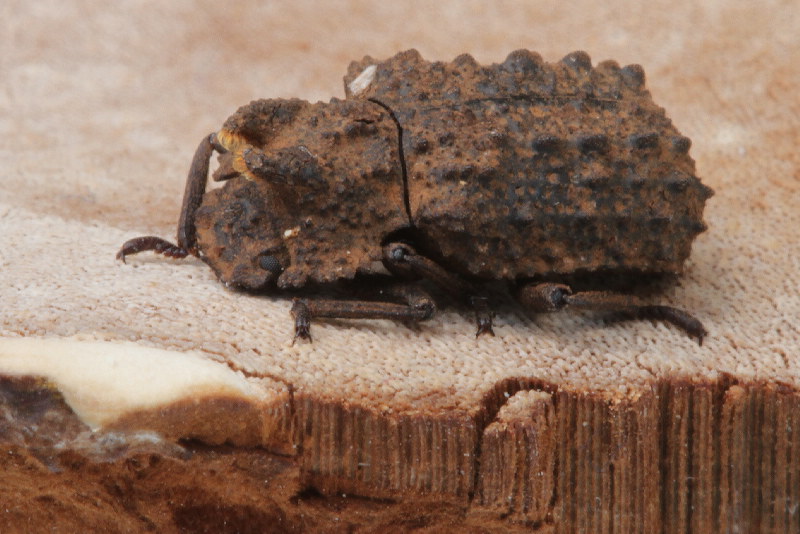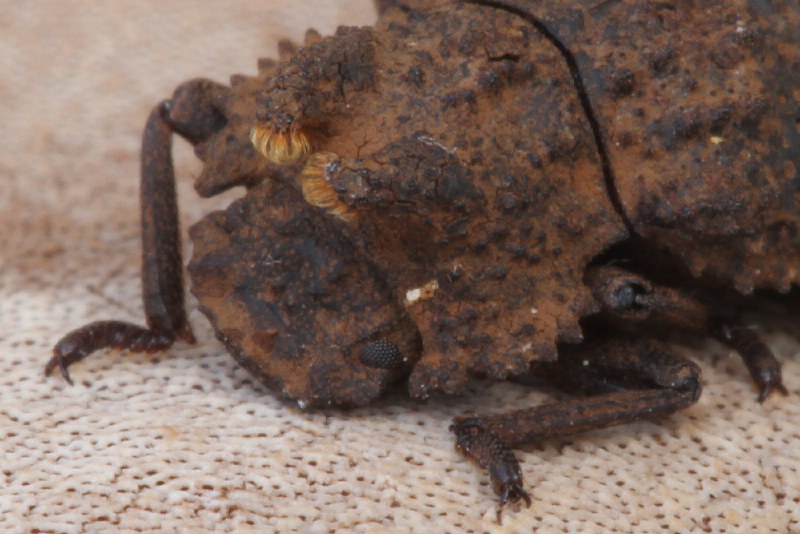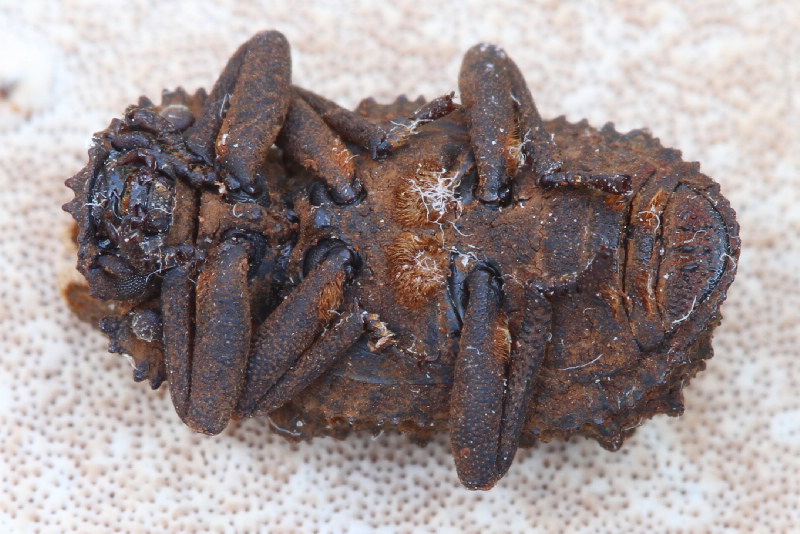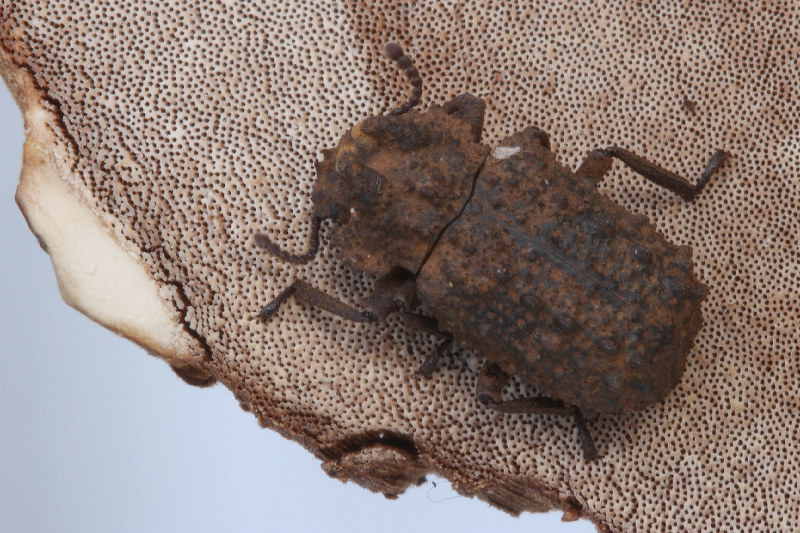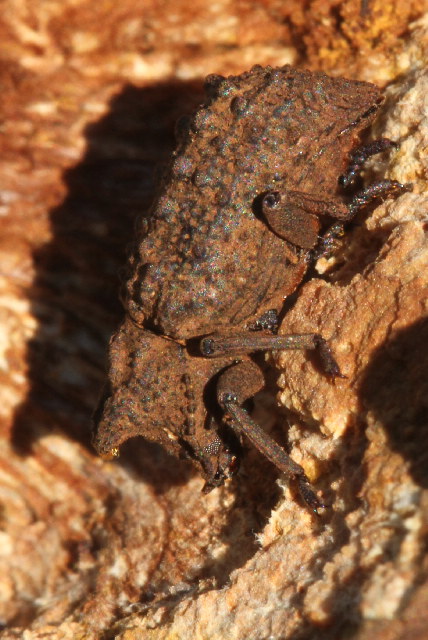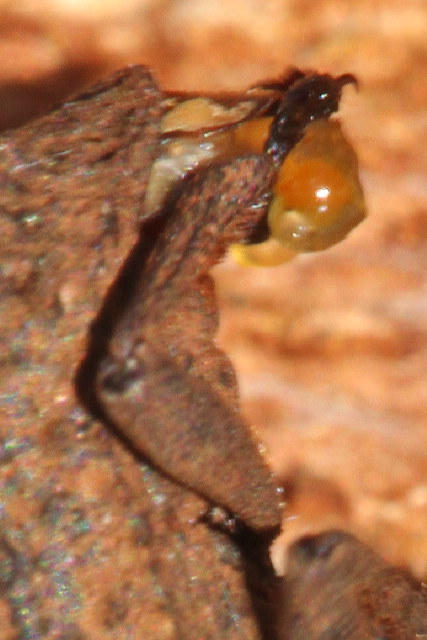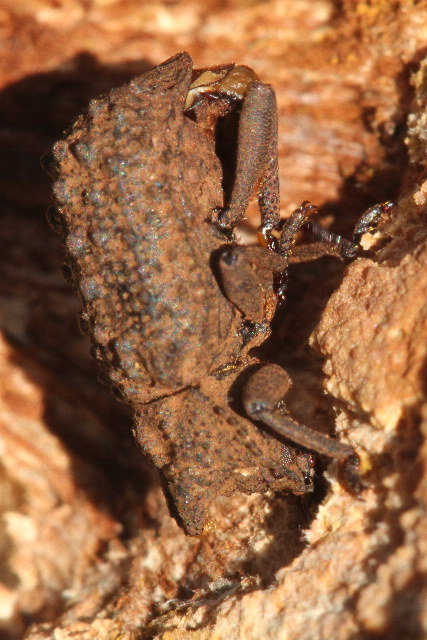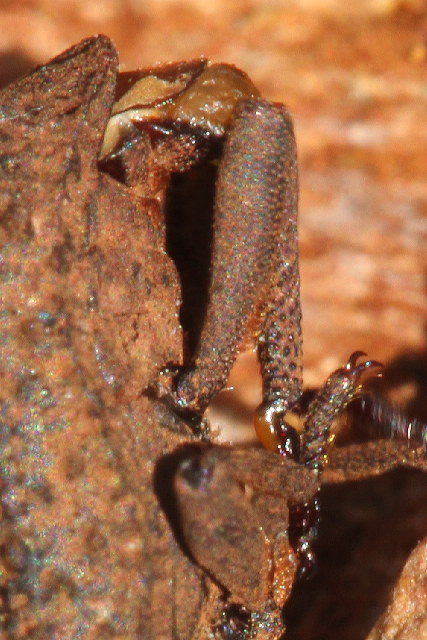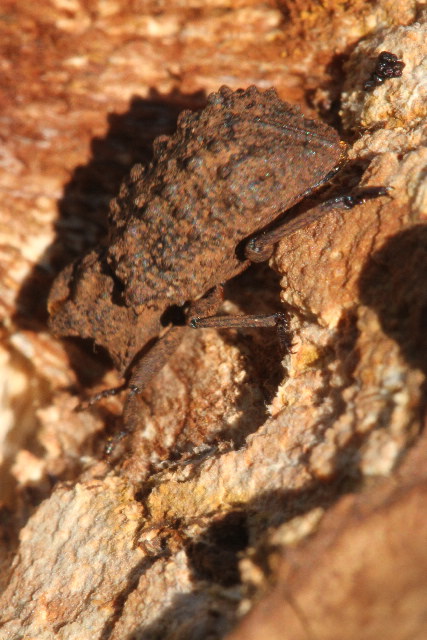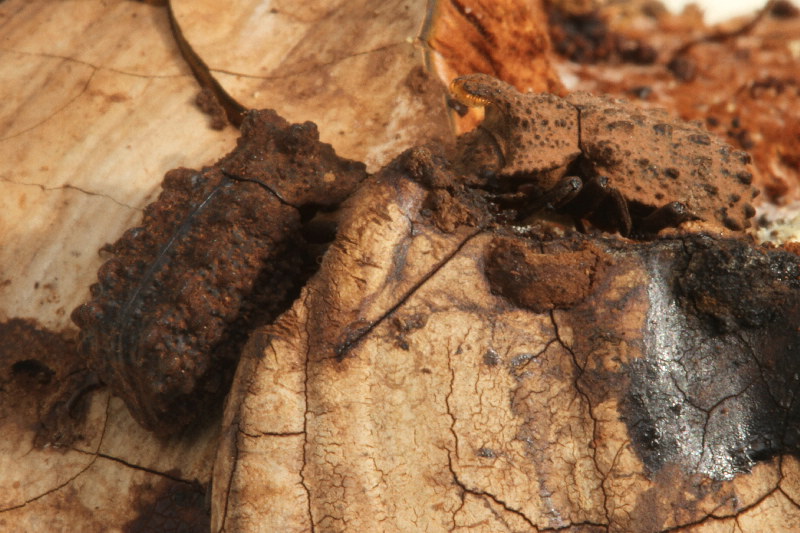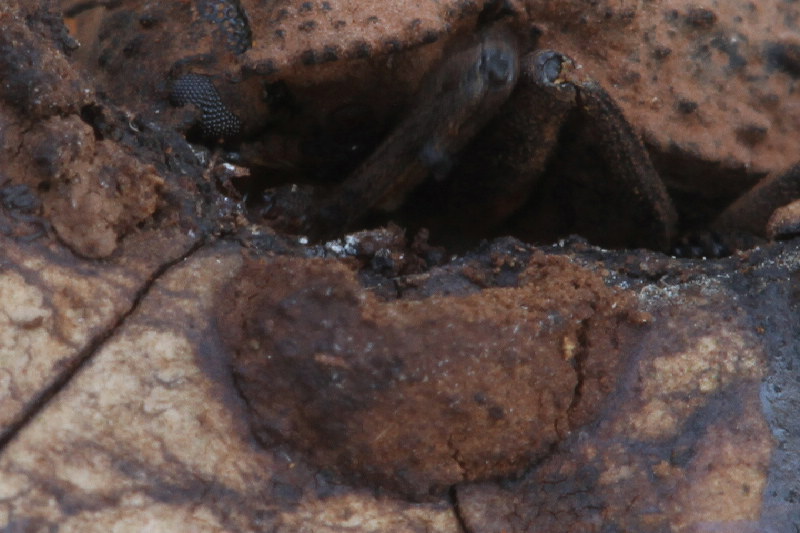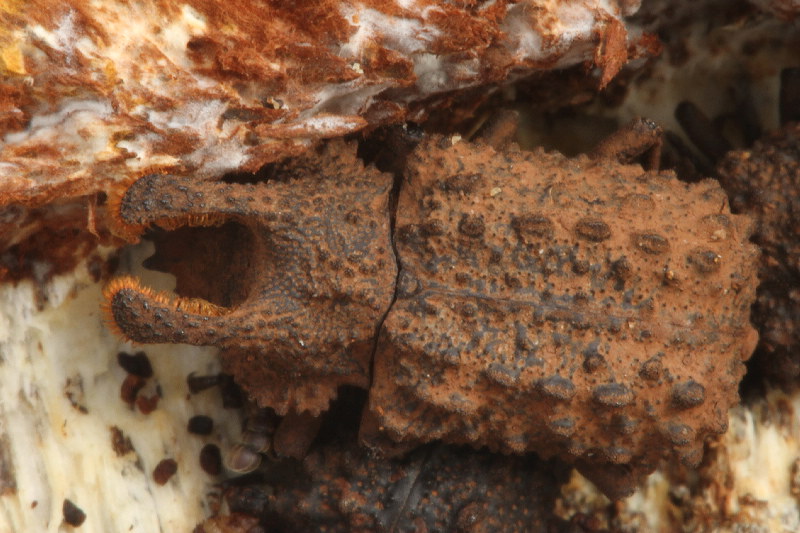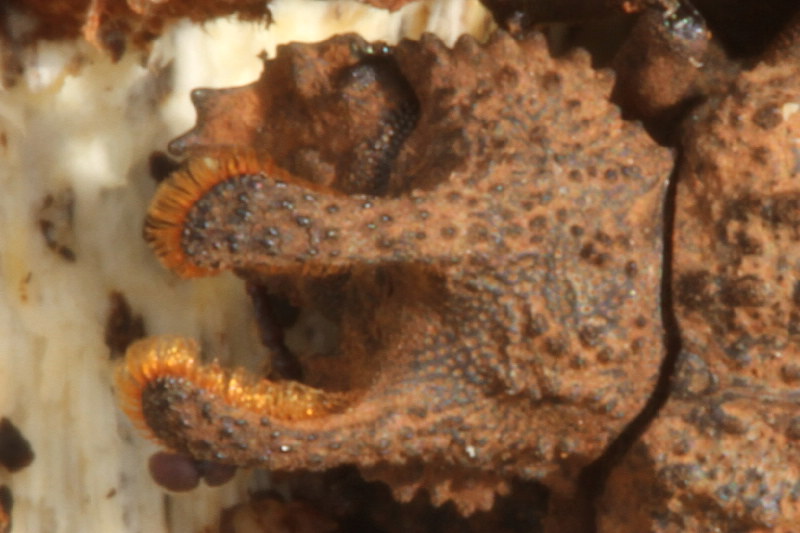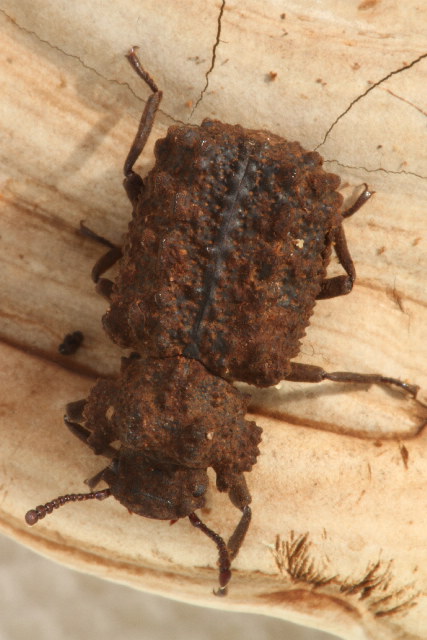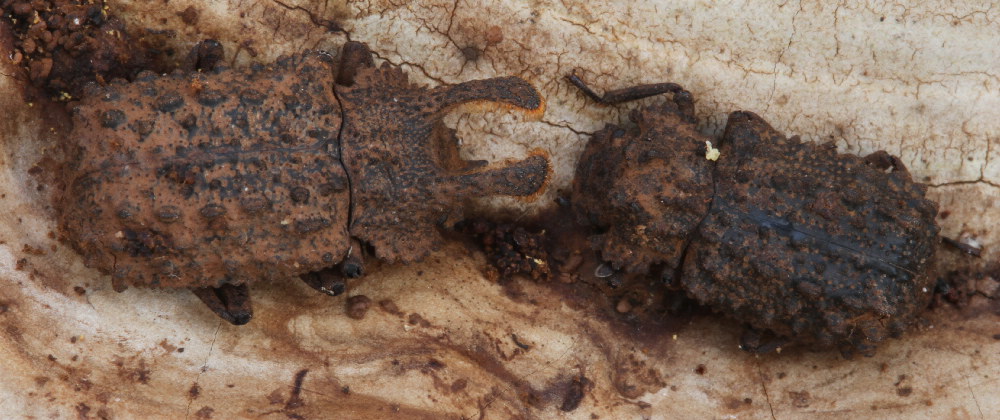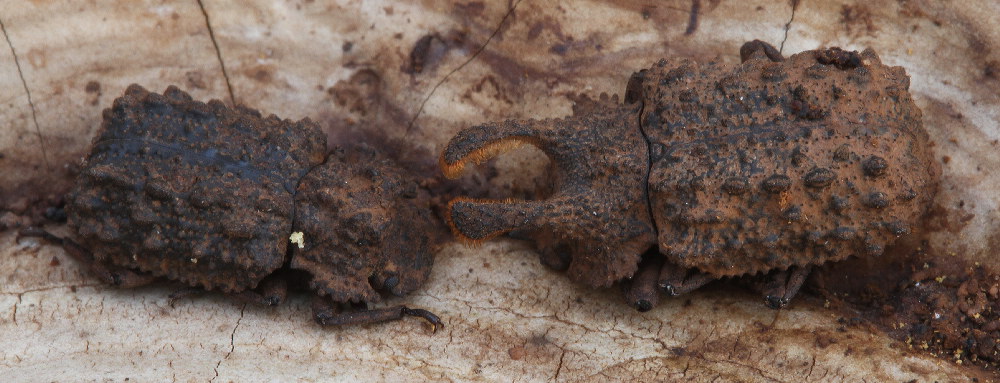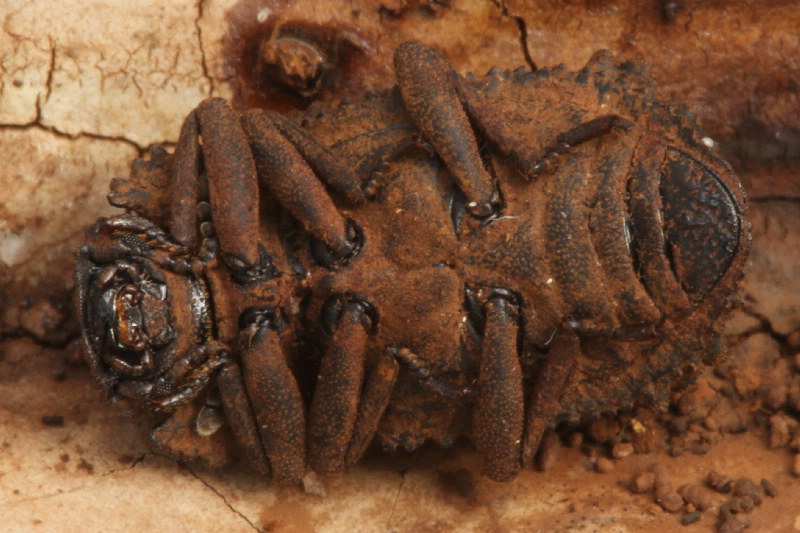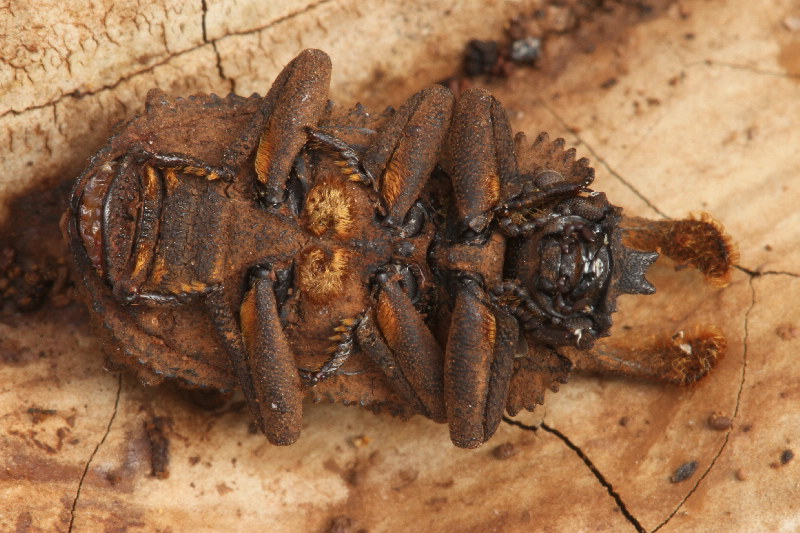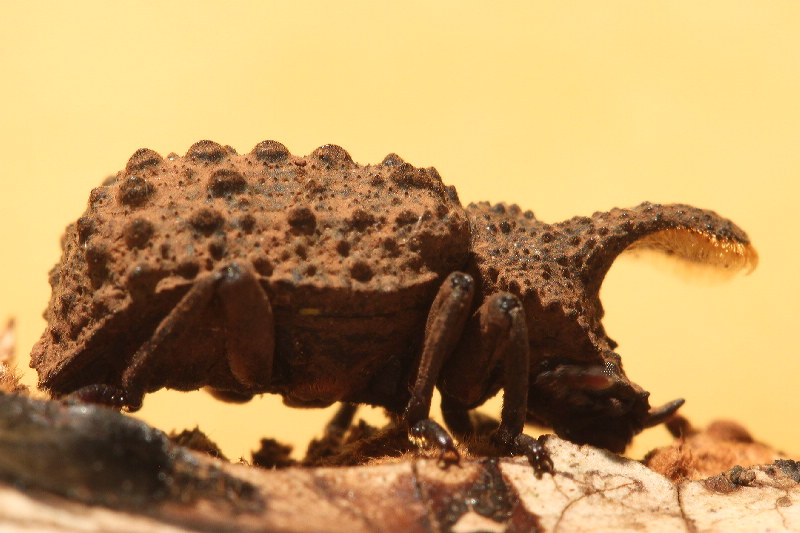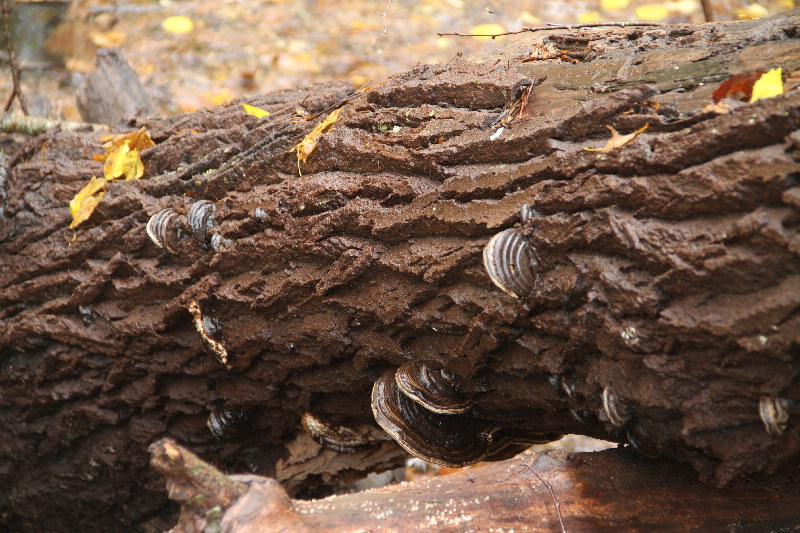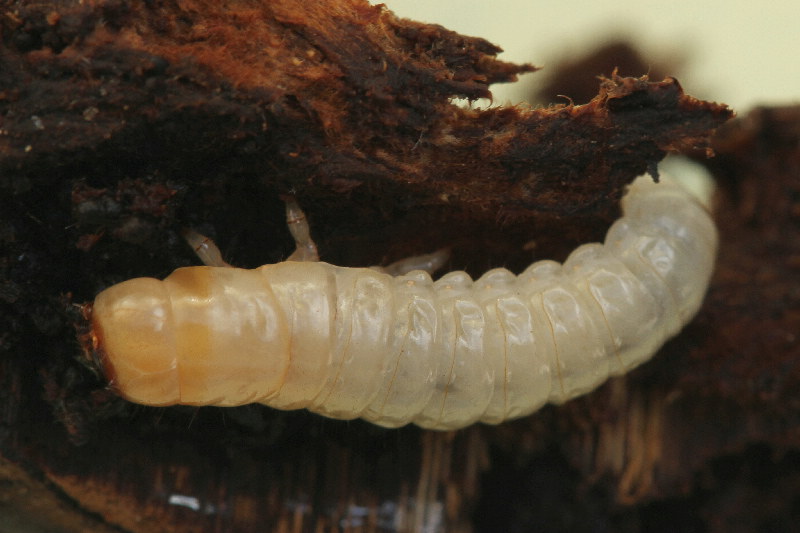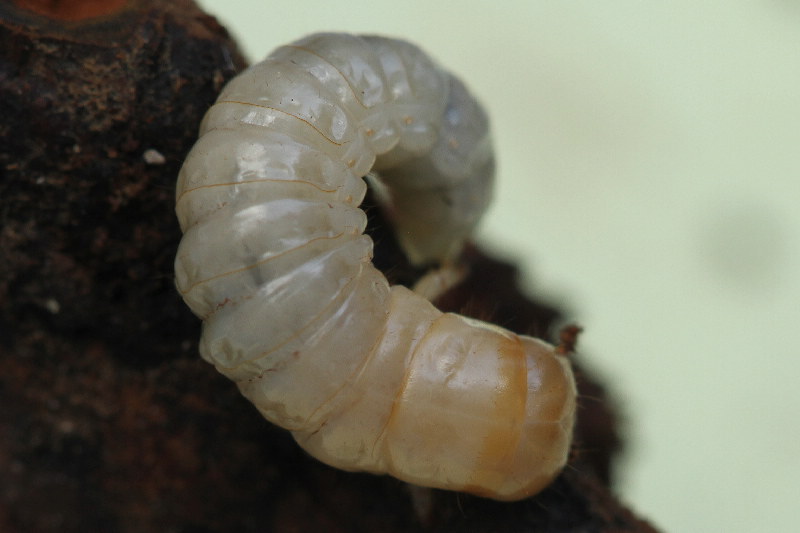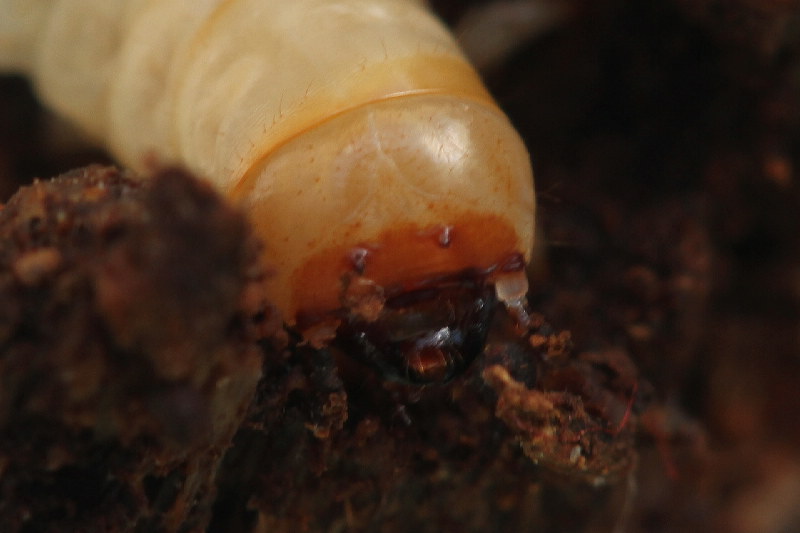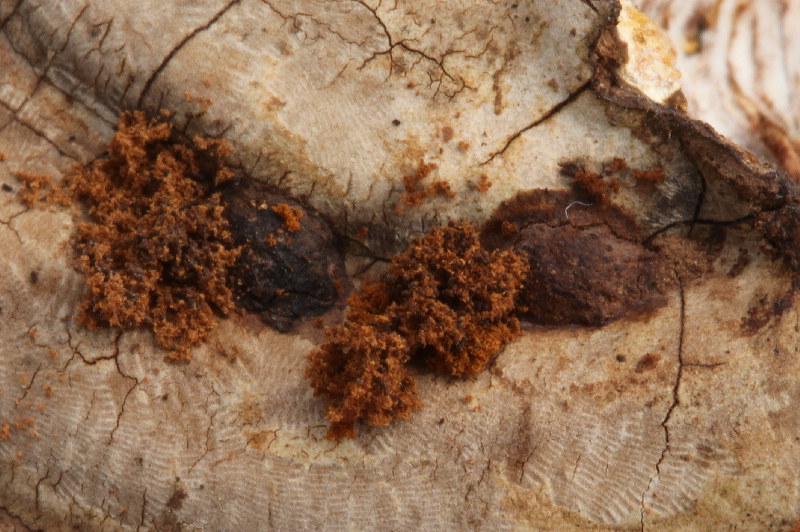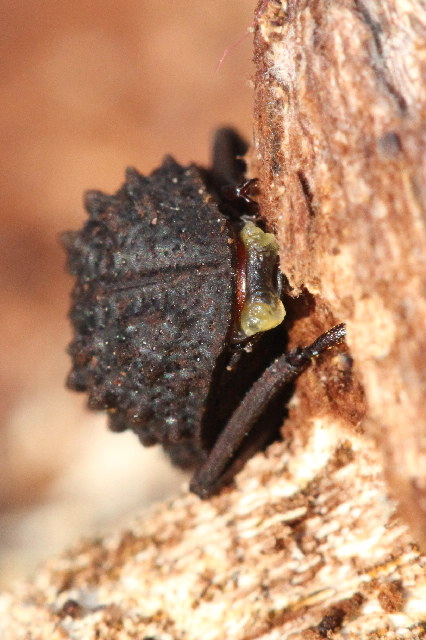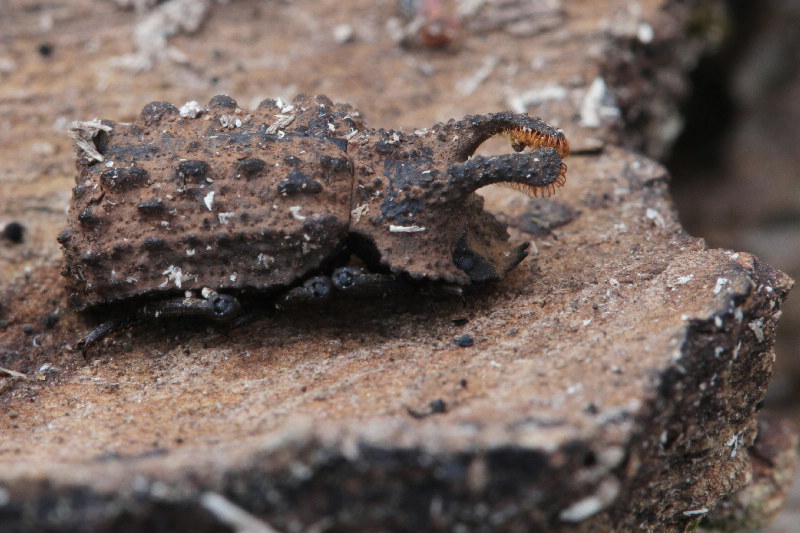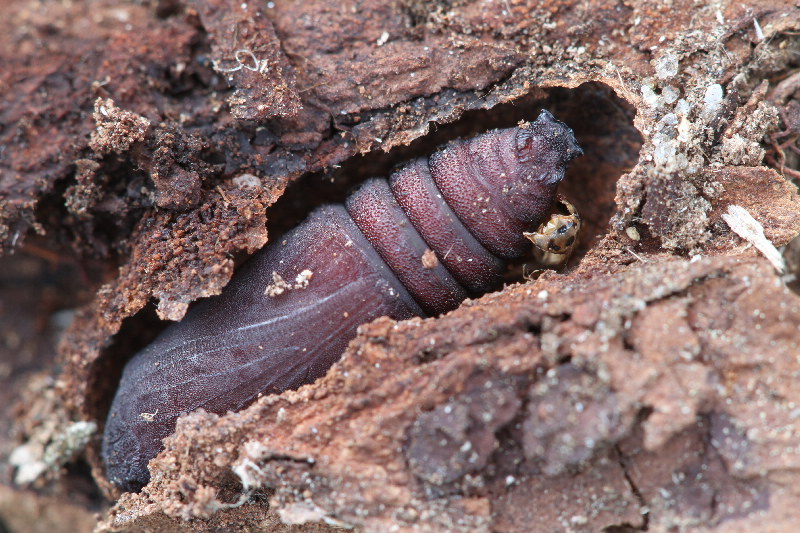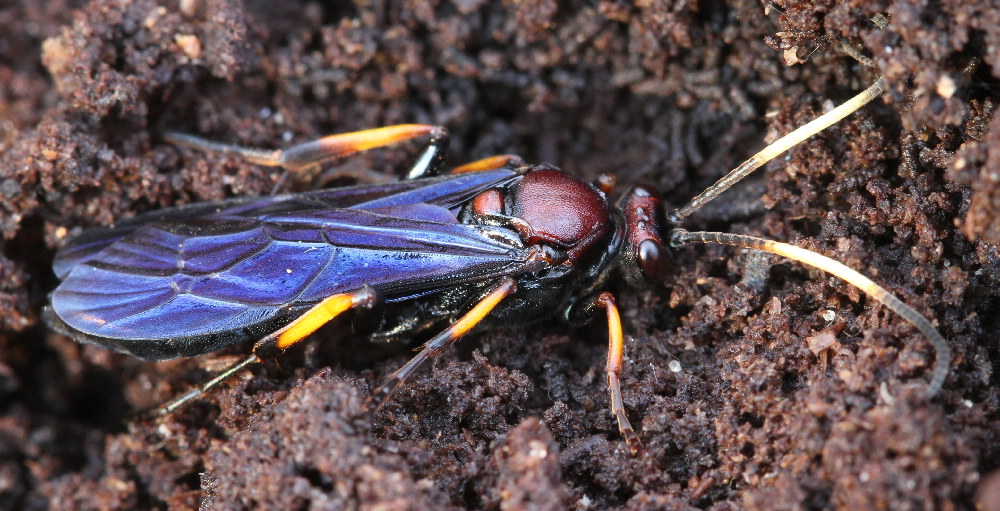Forked Fungus Beetles - Fall, 2011 Bolitotherus cornutus - Stan Malcolm Photos - Marlborough, Connecticut |
mAir Line Home Page |
October 15th. A highlight of a walk on the Air Line Trail northeast from Route 87 in Lebanon, CT, was finding this male Horned (or Forked) Fungus Beetle (Family Tenebrionidae, Bolitotherus cornutus) on an Artist's Conk fungus. In this photo it's hunkered down, playing dead - more specifically, looking like a crumb of woodland detritus. |
Note the paired hairy horns on the body segment just behind the head (pronotum). |
(Ignore the white strands which I think are contaminant fibers of paper towel from the container I kept it in.) Various patches of hair on the underside are curious too. Are they sensory, or do they disperse pheremones or other chemicals? Stay tuned! |
Antennae and legs extended, the beetle is about to wander off. An introduction to the species here: http://www.insectsofwestvirginia.net/b/forked-fungus-beetles.html Additionally, see "Secret Weapons: Defenses of Insects, Spiders, Scorpions, and Other Many-Legged Creatures" by Thomas Eisner, Maria Eisner, and Melody Siegler. This fungus beetle is discussed in Chapter 50 (pp 232-235). The next chapter discusses Eleodes longicollis, a desert Tenebrionid with some similar defensive capabilities (pp 236-240). |
Signaling a right turn. |
Not a very good video, but interesting to watch it walk. |
October 16th. According to several sources, these beetles have eversible glands at the tip of the abdomen which release noxious benzoquinones when the beetles are threatened. |
I decided to threaten the beetle. The preferred technique is to gently puff your breath onto the beetle. (According to Eisner, etal, in "Secret Weapons...", the puffs must be "humid, warm, and pulsed - truly breathlike.") |
It worked like a charm. Not only did the beetle evert the glands, but it reared up (literally) off its hind legs... |
...wiped them against the glands,... |
...and carried the chemicals forward to spread them... |
...on the metasternal and femoral hair patches further forward on the underside. |
With its noxious chemicals spread out, it defecated and wandered off (wondering, if beetles could wonder, what kind of jerk had been annoying him). |
October 17th. I revisited the spot where I found the beetle on the 15th - and came away with eight more specimens and another bracket fungus to sustain and shelter them. All these beetles were on conks on the same downed tree as before. When at rest, they tend to seek shaded crevices. I saw no evidence of territoriality. (I did see a lot of their excrement.) |
At left, a female wanders past a male at rest. Females lack the elaborate pronotal "horns" of males. |
Side view of a male. |
The crescent-shaped mass below him would have enclosed an egg. There are a number of these structures on the conks I harvested. Some have holes in them. |
The same male, from above. |
The size of the male horns varies between individuals. (The horns on the one I captured on October 15th were much shorter.) |
There's some suggestion in the literature that the "horns" play a role in jousting with other males. Maybe, but why the dense setae on the underside of the horns? |
Females lack horns. Instead they have a pair of simple tubercles on the pronotum. No setae on them. |
These two beetles were just hanging out, not interacting. A decent demo of the difference between the male and female... |
...but note that body size varies in both sexes; males aren't always larger. |
The underside of females is also bare of the setal patches found on males (see below). They do possess the defensive glands I show above in a male. (Eisner, etal, picture them everted in a female.) In both males and females, tucking the legs in (and falling if they are not on a level surface) is the typical defensive reaction to being touched. I speculate that the beetles first try to deter an approaching threat (mouse?) with defensive secretions. However, if touched they curl up and (often) drop into the leaf litter below. But dropping has a cost in trying to re-establish contact with the fungus so it's more of a last resort. |
The underside of a male. Note the setal patches on several of the abdominal tergites, the paired patches on the metasternum, on the base of all six femora, on the tarsomeres, and on the underside of the pronotal horns. Note too the forked forward-pointing extension of the clypeus. (On males with smaller horns, this fork seems to be smaller too.) |
Sorry, lousy picture, but in side view you can see the forked clypeal extension projecting forward below the pronotal horns. According to the literature, males will try to pry other males off females in order to mate. You could speculate that the clypeus and the horns act together very much like a bottle opener - but I haven't observed this yet, and that still doesn't explain the setae on the horns. Here's a link to videos of jousting males: http://faculty.virginia.edu/vaformica/Video.html Note that the captions beside the links are mixed up, but it's easy enough to sort them out. The clypeus certainly is involved; but the horns not obviously to me. Credit to David Montgomery for the videos. (See below for more about David.) |
According to the literature cited above, prior to mating a male aligns itself on the female's back, rotated 180 degrees such that the tip of its abdomen is above the female's pronotal tubercles. The pair then "cooperatively stridulate" by rubbing those surfaces together. Looking at the underside of the male's abdomen, four raised bars on the penultimate sternite might be a stridulatory file. There's also a larger single bar on the last sternite. (This online photo by "Panomon-Creel" shows the male in the reversed position, though after mating has occurred: the female is laying an egg; the male presumably guarding his investment.) Do other insects cooperatively stridulate? (So far, the answer is a resounding, "No.") Why do these beetles do it? Here are two brief videos showing the side-to-side stridulatory movement of the male abdomen against the female pronotum: http://www.youtube.com/watch?v=TYolS7dpQr0) http://www.youtube.com/watch?v=HBJOAnApx0g These were taken by David Montgomery near the Mountain Lake Biological Station, Pembroke, Virginia. David and others are studying these beetles at the University of Virginia with Vince Formica. Many questions remain. For instance:
|
October 20th. After a day of heavy rain that kept me indoors, I went back to the downed trunk where I collected the beetles off the surface of the active sporocarps midway up the trunk. The base of the tree, towards the left, had some older sporocarps that were thoroughly rotten, with obvious large exit holes in the top surface and tunnels through the core. I wondered if adult beetles would shelter inside them. They do, though they were hard to find amid the litter of frass in the tunnels. |
Here are some of the active sporocarps further up the trunk where on warm dry days, I found adult beetles feeding or tucked into crevices. |
When I removed a rotten sporocarp, I found a number of mature larvae near the junction with the log in fungal tissue that had not decayed. I assume these will pupate between now and May or June when fresh adult beetles should emerge. There were also much smaller larvae. I don't know if those will mature next spring, or spend another season or year as grubs. |
Nice detail of the legs. |
|
A bit of motion blur mars this photo of the head. (The grub never stopped moving and I was shooting at 1/30th of a second.) |
|
|
A larva damaged in removing the conk from the trunk. Alive, but not moving much. |
Getting back to the oviposition sites, note the holes and the collection of fine frass below them. |
Another spot with similar accumulations. Seems like the small developing larvae deposit their excrement outside their burrows. This is on a conk that was brought in a few days ago. I'm guessing that in the field, dew, rain, and breezes would disperse these signs of the larval activity inside. |
Okay, so what made the scalloped markings on the surface of the conk, below the frass? Apparently a slug or snail passed by, scraping the surface with its radula. (See"Tracks and Signs of Insects and other Invertebrates" by Charley Eiseman and Noah Charney; p 292.) |
October 28th. A male with its defensive scent glands everted. |
|
Just for fun, watch the male try to right itself. Best viewed full screen in order to see how the basal leg joints move and how those motions translate into movement of the leg as a whole. |
November 7th. A warm sunny day for November (and my 64th birthday). I visited the site near Route 87 in Lebanon where I photographed Forked Fungus Beetles last month. I was curious where they would be. I found three under loose bark of the trees hosting fungus. Two of the three were upside down, clinging to the loose bark, presumably tucked away for the winter. |
I also found this moth pupa in a cavity formed by the larva under the bark. |
May 2012 update: The moth emerged from this pupa. It was an Eight-spotted Forester (Alypia octomaculata). |
Similarly, I found two colorful adult Ichneumon wasps (Family Ichneumonidae) in rough cavities under the bark. One became active immediately (see following crude video), while the other posed for still images. (I replaced the bark as well as possible when I was done.) |
|
Ichneumonids parasitize other insects, typically each wasp species is tied to one or a few insect host species. If you identify the wasp, you can often reliably identify the host insect larva it grew up in. With thanks to the volunteers at BugGuide.net, especially Ross Hill and Bob Carlson, I now know that this is a female Ichneumon centrator and that it developed as a parasitoid of the Wooly Bear caterpillar (Pyrrharctia isabella See: http://mothphotographersgroup.msstate.edu/species.php?hodges=8129 ) |
